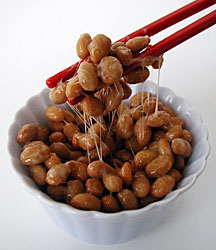|
Key Ingredient
|
Natto

|
Natto is another case in point. The slimy beans have been compared to sewage, stinky cheese and something that you scrape off from under your shoes, but there are those who just can't get enough of them.
The basics: Natto is fermented cooked soybeans, a staple of the Japanese breakfast. It is believed that natto was derived by mistake when Japanese farmers discarded cooked soybeans on rice straw.
Particular bacteria in the straw caused fermentation and transformed the beans into a healthy delicacy. Natto is rich in minerals such as calcium and potassium and is a good source of B vitamins.
Some research has also shown that natto aids in preventing heart disease and other circulatory disorders.
The soybeans are cooked for several hours until tender, then a particular bacteria is added to start the fermentation process. The beans ferment for about a day, then are refrigerated or frozen.
The soybeans are caramel brown and look harmless at first. It's when the beans are stirred that their slimy texture is revealed. A slightly ammonia aroma is also released -- offensive to some, mouthwatering to others.
Selecting: Natto is sold fresh or frozen in small Styrofoam or plastic containers. Fresh natto is generally produced by local tofu manufacturers, while frozen natto is imported from Japan. Frozen natto comes in many varieties, from small to large beans, packed with condiments such as hot mustard, dashi sauce or even kim chee flavoring.
Storing: Fresh natto must refrigerated and should be consumed within one or two days. It can be frozen, although some nutritional value will be lost. After defrosting, however, consume immediately.
Use: Natto is ready to eat out of the container. No cooking is necessary, although it can be heated if preferred. It is generally eaten for breakfast over a bowl of hot rice.
Natto can be embellished with a bit of soy sauce, hot mustard or dashi sauce, or to increase the slime factor, the Japanese crack a raw egg into it -- a practice not recommended in the West. Frozen natto, once defrosted, can be eaten at room temperature or heated slightly in the microwave.
The Japanese also enjoy natto in miso soup, with spaghetti, in sushi, as a gyoza filling and in curry dishes.
Where to buy: Natto is available in most supermarkets near fresh tofu or in the frozen section of Asian markets. Prices are reasonable, but vary greatly depending on quantity and whether or it is fresh or frozen.
![]()
a free-lance food writer. Contact her
online through features@starbulletin.com
[News] [Business] [Features] [Sports] [Editorial] [Do It Electric!]
[Classified Ads] [Search] [Subscribe] [Info] [Letter to Editor]
[Feedback]
